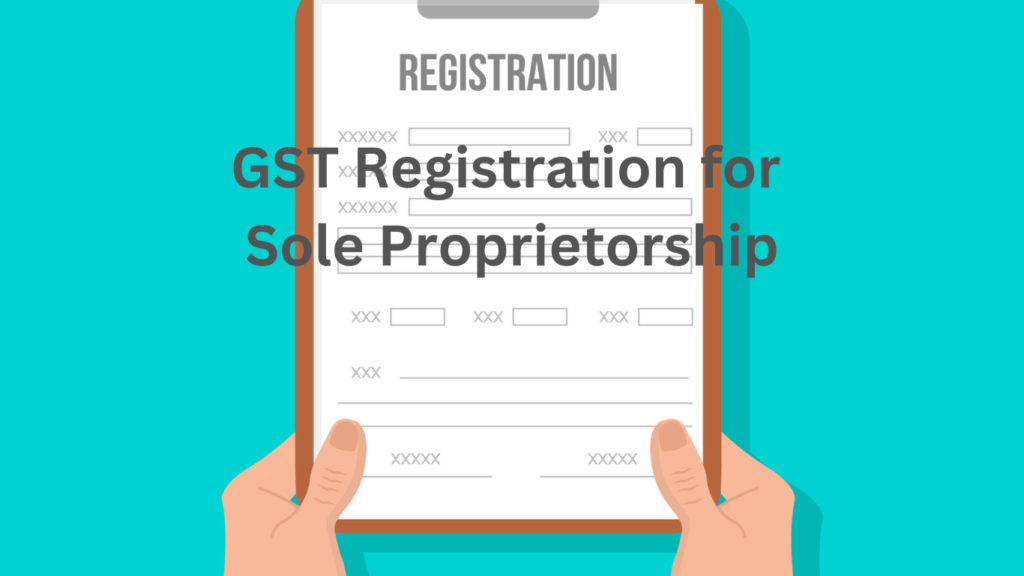Learn the step-by-step process for GST registration for sole proprietorships in India. This comprehensive guide covers everything from TRN generation to final submission, including required documents, Aadhaar authentication, and key tips for a smooth registration.
GST (Goods and Services Tax) registration is required for businesses that reach a certain threshold in revenue or choose to register voluntarily. For sole proprietors, GST registration enables easier tax filing, legal compliance, and access to a GSTIN, which enhances business credibility.

What is a Sole Proprietorship Firm :
A sole proprietorship is a business run by a single individual. It’s easy to start, doesn’t require complex registration processes like LLPs or private limited companies, and is perfect for those just beginning their business journey. Unlike other business structures, you don’t need to register it with many formalities, though having a GST registration, MSME registration, or a trade license can be beneficial. These registrations can also help in opening a business bank account.
Benefits and Limitations:
A major benefit of sole proprietorships is their simplicity and full control over profits and decisions. However, they come with unlimited liability, meaning personal assets could be at risk if business debts can’t be covered. Additionally, raising investment is challenging, as the structure doesn’t allow for shareholders or multiple owners.
How to apply GST registration Steb by Step process :
Step 1: Visit the GST Registration Portal
To get started with online GST registration, click here to go to the official GST website
Step 2: Create a Temporary Reference Number (TRN)
On the homepage, select the “I am a taxpayer” option.
1. Choose your state and district from the dropdown menus.
2. Enter your legal name of business. If you’re registering as an individual or sole proprietor, this will be your name (as per your PAN card).
3. Provide an email address and mobile number for OTP verification.
Enter the captcha code and proceed. You’ll receive two OTPs – one on your mobile and one on your email.
4. After entering the OTPs, a TRN (Temporary Reference Number) is generated and sent to your email. Save this TRN as you’ll need it for further steps.
Step 3: Log in with Your TRN
1. Return to the GST portal and click the “Login” button.
Enter your TRN and captcha code to access the application.
2. Your application for GST registration will appear. Click on “Proceed” to start filling in your business details.
Step 4: Enter Business Details
Your application will be divided into several sections: Business Details, Promoters Details, Business Address, Goods and Services, and more.
1. Enter your trade name (business name) and choose the business structure (e.g., “proprietorship”). You’ll also need to select the reason for GST registration; if voluntary, select “Voluntary Basis.”
2. Enter the start date of your business.
3. If you have a Shop Act License or any other registration, add the details and upload relevant documents. If not, skip this step.
Step 5: Promoters and Partners Details
In this section:
1. Enter your details, including your PAN card name, father’s name, date of birth, mobile number, and email.
2. Add your Aadhaar card details for address verification. Ensure your address matches exactly with your Aadhaar card.
Step 6: Principal Place of Business
1. Enter your business address (office or shop location). You’ll need to pinpoint this on the map provided in the application.
2. Upload supporting documents, like an electricity bill or NOC, especially if the property is rented. At least two documents are required.
Step 7: Add Goods and Services
For businesses dealing in goods, enter the HSN code, for services, use SAC codes.
Start typing the code or relevant business segment and a dropdown list will appear. Select the correct HSN/SAC code for your business.
Step 8: Professional Tax and Additional Details (State-Specific)
Some states, like Maharashtra, may ask for additional documents like an electricity bill. If this applies to your state, make sure to provide these details. Otherwise, you can skip this step.
Step 9: Aadhaar Authentication
For Aadhaar authentication, click on “Yes” and submit. An OTP will be sent to the Aadhaar-linked mobile number.
Enter the OTP to complete the Aadhaar-based e-KYC verification.
Step 10: Final Submission and EVC Code Verification
At the end of the application, enter your name and place, and submit your application with an EVC code sent via OTP.
Congratulations! You’ve completed the first step of your GST registration.
Post-Submission Steps for GST Registration for Sole Proprietorship
After submitting your application:
Verification: Most states don’t require physical verification. Instead, a link for Aadhaar OTP verification will be emailed to you.
ARN Generation: Once your verification is complete, an ARN (Application Reference Number) is generated to track your application status.
Additional Step (Physical Verification)
In states requiring physical verification, you’ll need to book an appointment at a GST centre. Bring original documents for verification.
Approval and GST Certificate Download
Once approved, you’ll receive an email with your user ID and password to log in and download your GST certificate.
This step-by-step guide simplifies GST registration for how to apply GST for sole proprietorship in India. Following each step accurately will ensure a smooth registration experience, helping your business stay compliant and ready for growth.
FAQs on GST Registration for Sole Proprietorship
Can a sole proprietor apply for GST registration voluntarily?
Yes, even if your revenue is below the threshold, you can voluntarily register for GST to benefit from input tax credits and improve your business’s credibility.
What is a TRN in GST registration?
TRN stands for Temporary Reference Number. It is generated during the initial steps of the GST registration process and is used to log in and complete your application.
Is Aadhaar authentication mandatory for GST registration?
Yes, Aadhaar authentication is essential for verifying the applicant’s identity and completing the registration process.
What are HSN and SAC codes, and how are they relevant?
HSN codes (Harmonized System of Nomenclature) are used for businesses dealing with goods.
SAC codes (Service Accounting Codes) are for service-based businesses.
These codes classify the goods or services offered by your business for tax purposes.
How long does it take to receive the GSTIN after applying?
After successful submission and verification, the GSTIN is usually issued within 3-7 business days.
Can physical verification be required for GST registration?
In some states, physical verification may be required. If so, you will need to visit a GST centre with original documents.


